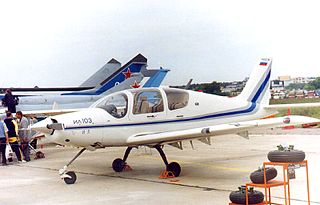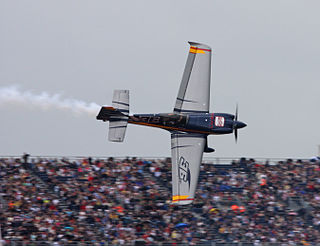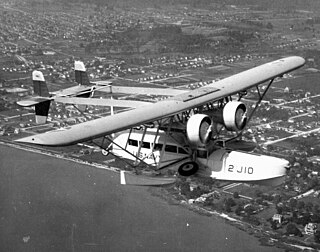
The Zivko Edge 540 manufactured by Zivko Aeronautics is a highly aerobatic aircraft. Capable of a 420 degree per second roll rate and a 3,700 foot per minute climb rate, it has been flown to victory on the international Unlimited aerobatics circuit several times since the mid-1990s. A tandem-seat version is sold as the Edge 540T.

The Piper PA-44 Seminole is an American twin-engined light aircraft manufactured by Piper Aircraft.
The Alexander Eaglerock was a biplane produced in the United States in the 1920s by Alexander Aircraft Company of Colorado Springs, Colorado.

The Pitcairn Mailwing family is a series of American mail carrier and three-seat sport utility biplane aircraft produced from 1927 to 1931.

The Bartlett LC-13A Zephyr 150 was a United States light civil aircraft built in the 1940s. It was a mid-wing braced monoplane of conventional design with side-by-side seating for two and fixed, tailwheel undercarriage. It was originally marketed as the Babcock LC-13 by its original manufacturer, then as the Taubman LC-13 when the Babcock Airplane Corporation was acquired by Taubman Aircraft. The rights were finally acquired by Bartlett Aircraft in 1941, but plans to mass-produce it were halted by the outbreak of World War II. There was a brief attempt to revive the design at the end of the war, but nothing came of this.

The Bellanca CH-400 Skyrocket is a six-seat utility aircraft built in the United States in the 1930s, a continuation of the design lineage that had started with the Bellanca WB-2. Retaining the same basic airframe of the preceding CH-200 and CH-300, the CH-400 was fitted with a more powerful Pratt & Whitney Wasp radial engine.

The Cessna Model CW-6 was a 1920s American six-seat touring aircraft built by the Cessna Aircraft Company.

The Colonial Model C-1 Skimmer was an American small single-engined amphibian flying boat built by the Colonial Aircraft Corporation. It was the start of a line of very similar aircraft designed by David Thurston.

The Heinkel HD 42 50, later designated the Heinkel He 42 was a German two-seat biplane seaplane originally designed for the Deutsche Verkehrsfliegerschule, and later built for the German Luftwaffe. The aircraft was used until the end of World War II as a trainer for maritime pilots.

The Rose Parrakeet was a single-seat sporting biplane produced in small numbers in the United States during the 1930s. It was a conventional design with staggered single-bay wings of equal span braced by N-struts. The cockpit was open, and the fixed tailskid undercarriage had divided main units. An unusual feature was the use of a single strut in place of the usual flying wires.

The IAR-46 is a very light two-seater airplane for flight schools, training and tourism. Construction uses conventional riveted joints. The seats are arranged side by side, the conventional left seat being the pilot or student pilot seat. The aircraft has a low trapezoidal wing, empennage in "T" configuration, semi-retractable landing gear (mechanical), with the tailwheel connected to the rudder.

The Ilyushin Il-103 is a single-engine, low-wing training aircraft developed by the Ilyushin Design Bureau that started in 1990 in the Soviet Union. The aircraft is now produced in Russia. It was the first Russian aircraft to achieve Federal Aviation Administration certification in 1998, it is for sale in the United States.

The MXS is a single-seat aerobatic aircraft made of carbon fiber and built by MX Aircraft Company, a manufacturer located at Jandakot Airport in Perth, Western Australia. The MXS-R is a race variant flown by several pilots in the Red Bull Air Race World Championship. The planes are all-composite in construction, piston-powered, low-wing monoplanes. They are produced both in kit form for amateur construction, and completed ready to fly at the factory.

The Sikorsky S-41 was an amphibious flying boat airliner produced in the United States in the early 1930s. Essentially a scaled-up monoplane version of the Sikorsky S-38 biplane flying boat, Pan Am operated the type on routes in the Caribbean, South America, and between Boston and Halifax.

The X-Air Hanuman is a two-seat, fixed tricycle gear, general aviation ultralight airplane, manufactured in India by Raj Hamsa Ultralights. It is used primarily for flight training, touring, and personal flying. The aircraft is known in North America as the X-Air "H".
The Solar MS-1 was an American prototype all-metal sesquiplane airliner built in 1930.
The Alexander Airplane Company D-1 Flyabout was an early entry into the light aircraft market by the popular biplane aircraft manufacturer. The aircraft was later manufactured by Aircraft Mechanics, Inc.

The Micro Aviation B22 Bantam is a New Zealand ultralight aircraft, designed and produced by Micro Aviation NZ of Hamilton, New Zealand and later of Mandeville, New Zealand. The aircraft is supplied as a complete ready-to-fly-aircraft.

The Starfire Firebolt, sometimes called the Starfire Firebolt Convertible, due to its removable canopy, is an American homebuilt aerobatic biplane that was designed by G. H. "Mac" McKenzie and produced by Starfire Aviation of Tempe, Arizona. When it was available the aircraft was supplied in the form of plans for amateur construction, with some pre-fabricated parts available.

The Vega Model 2 Starliner was a prototype five-seat feeder airliner produced by the Vega Airplane Company, a subsidiary of Lockheed. It was designed to be powered by an unusual powerplant, consisting of two Menasco piston engines coupled together to drive a single propeller. A single example was built, flying in 1939, but no production followed.



















